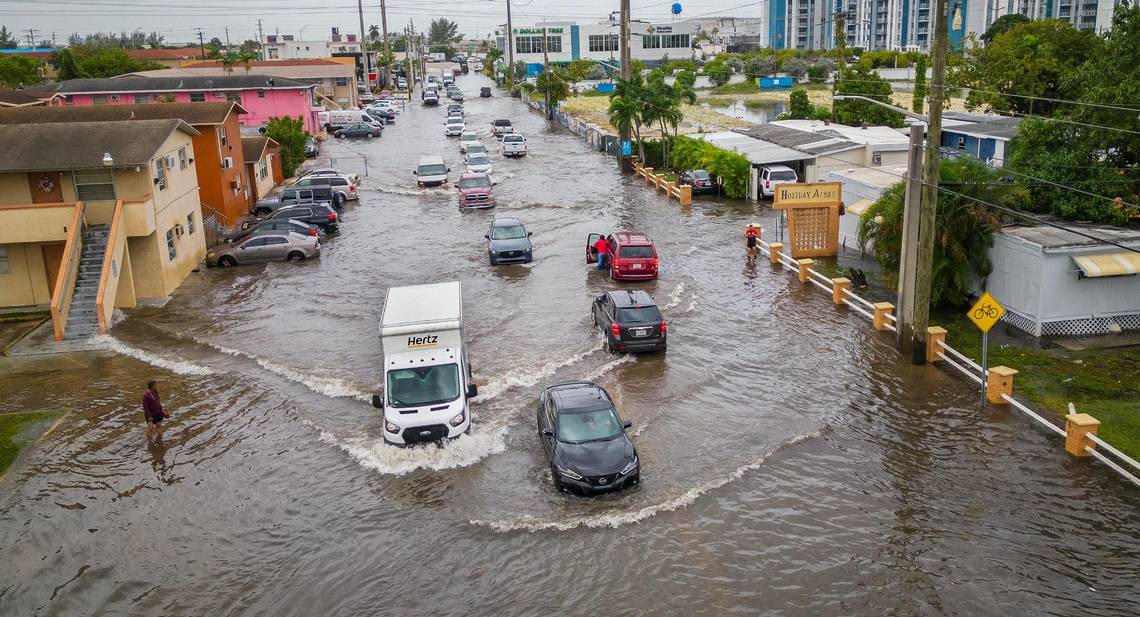A flooded street caused by the rain and storm surge from Hurricane Debby on Aug. 05, 2024, in Cedar Key, Florida.
Joe Raedle | Getty Images
You need a separate insurance policy for floods
A house is surrounded by floodwaters from Tropical Storm Debby on Aug. 6, 2024 in Charleston, South Carolina.
Miguel J. Rodríguez Carrillo | Getty Images
Flooding causes 90% of annual disaster damage in the U.S., according to the Federal Emergency Management Agency.
Just an inch of water can cause roughly $25,000 of damage to a property, the agency said.
Homeowners and renters insurance policies do not cover flood damage, however.
Consumers need separate insurance to cover physical damage caused by a flood, which is defined as water entering a home from the ground up. That may occur due to storm surge, heavy rainfall or an overflowed body of water like a lake or river.
Most people who have flood insurance get it through the federal government, via FEMA’s National Flood Insurance Program, experts said.

Americans had about 4.4 million residential NFIP policies at the end of 2023, according to FEMA. They had total coverage of $1.2 trillion.
Many homeowners go without coverage, though. On average, about 30% of U.S. homes in the highest-risk areas for flooding have flood insurance, according to the University of Pennsylvania’s Wharton Risk Center.
Nearly 21,000 policyholders filed a claim in 2023, with an average payment of almost $46,000, according to FEMA data.
The average annual flood insurance premium was $700 in 2019, FEMA said.
Private insurers also offer flood policies and may offer higher coverage than FEMA’s policies, according to the Insurance Information Institute.
What items aren’t covered in a basement?
A Johnson, Vermont, resident removes items destroyed in flooding of a finished basement in 2023.
Jessica Rinaldi/The Boston Globe via Getty Images
American basements can be a hodgepodge of personal property, leveraged as storage units, man caves, game rooms, wine cellars, home bars and secondary living rooms.
But basement coverage “is limited” through NFIP policies, FEMA said.
The agency defines a “basement” as any area of a building with a floor below ground level on all sides.
Even rooms that aren’t fully below ground level — like sunken living rooms, crawlspaces and lower levels of split-level buildings — may still be considered basements, the agency said.
Its flood policies exclude the following items from coverage in a basement:
- “Personal property” like couches, computers, or televisions
- Basement improvements (such as finished flooring, finished walls, bathroom fixtures, and other built-ins)
- Generators (and similar items)
- Certain dehumidifiers
Items “stored in a basement, meaning they are not connected to a power source,” aren’t covered, FEMA said.
Consumers concerned about flood risk and insurance coverage should consider removing their stuff from a basement, if possible, Kochenburger said. They should “move it to a storage unit or somewhere else” on higher ground, he said.
These basement items are included, with an add-on
A man uses a mop to wipe up rain water on the interior of the Lincoln Memorial on Aug. 09, 2024 in Washington, DC. The Washington DC area experienced a tornado warning and flooding as a result of remnants from Debby.
Anna Moneymaker | Getty Images
The following basement items are covered, but only if NFIP policyholders buy additional “contents coverage,” which is optional, and if connected to a power source, FEMA said:
- Clothes washers and dryers
- Air conditioners (portable or window units)
- Food freezers and the food in them (excluding walk-in freezers)
Private insurance policies may offer broader property coverage in basements, depending on the insurer, Don Griffin, vice president of policy and research at the American Property Casualty Insurance Association, previously told CNBC.
You can put anything you want in your basement, but don’t expect it to be insured for floods.
Peter Kochenburger
visiting law professor at Southern University Law Center
One silver lining to all this: Fewer U.S. homes are being built with basements.
The share of new single-family homes with full or partial basements has fallen by more than half since the mid-1970s, from 45% to 21%, according to U.S. Census Bureau data as of 2022.
On Feb. 6, FEMA announced a proposal to update its NFIP program and potentially enhance basement coverage for policyholders.
“Policyholders with basements continue to be surprised that under the current Dwelling Form, the policy provides limited coverage in a basement,” FEMA wrote.
What basement items are covered by flood insurance?
“Flood insurance’s primary focus is structure: the building itself,” Kochenburger said.
Here are examples of how NFIP policies cover the building and structure in basements, FEMA said:
- Central air conditioners
- Fuel tanks and the fuel in them
- Furnaces and water heaters
- Sump pumps, heat pumps, and well water tanks and pumps
- Electrical outlets and switches
- Elevators and dumbwaiters
- Certain drywall
- Electrical junction and circuit breaker boxes
- Stairways and staircases attached to the building
- Foundation elements and anchorage systems required to support a building

Policyholders can also get compensation for cleanup costs such as pumping out trapped floodwater, treatment for mold and mildew and structural drying of the interior foundation, FEMA said.
As a precaution, the agency recommends documenting the manufacturer, model, serial number and capacity of equipment in your basement like furnaces, central AC units and appliances like freezers, washers and dryers.
Should you experience flooding, the NFIP requires this information during the claims process, FEMA said.
Policyholders should review their flood insurance policy for a comprehensive list of covered items and expenses, according to FEMA.

